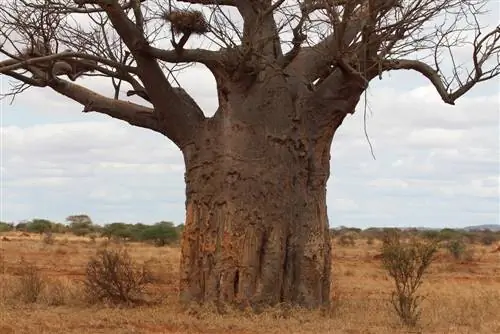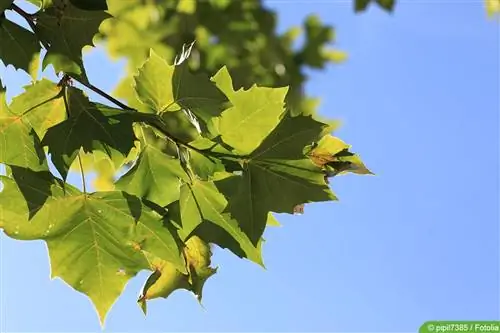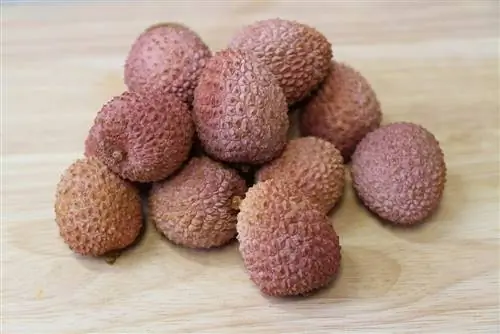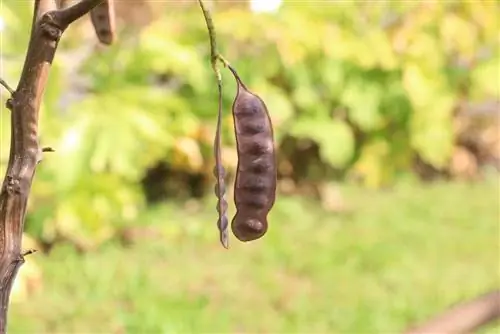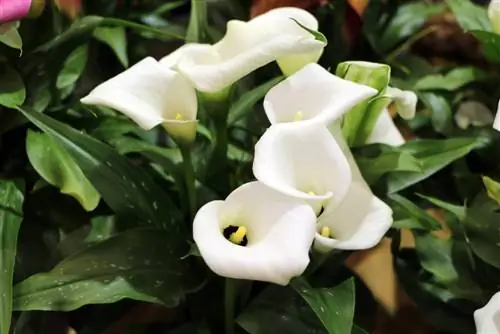- Author admin [email protected].
- Public 2023-12-17 03:39.
- Last modified 2025-06-01 06:48.
The African baobab is still not very common as a houseplant, which is difficult to understand: German indoor gardeners usually love the “most exotic plants” the most, and the baobab is definitely at the forefront in this respect. What's more, even when you're away from home, it's so exceptionally easy to care for that it should be a bestseller. This is exactly where the answer to the puzzle lies, baobab trees are hardly available to buy and growing plants is not for everyone. In this particular case, however, it's really worth a try, and with the baobab tree it's also pleasantly uncomplicated:
Profile: Baobab
- Mallow, subfamily of the woolly tree family (like kapok and balsa trees)
- Located primarily in the African tree savanna
- Characteristic tree of the African landscape
- With heights around 20 m, but remains much smaller in our cool climate
- Can therefore be cultivated as a potted plant
- Stores water in the trunk to survive dry seasons
- It therefore only needs to be watered rarely and otherwise requires little care
- For an exotic in a German household, surprisingly frugal and robust
- The chic potted plant grows up to 2 meters high
- But you have to put it on yourself as there is hardly any action yet
cultivation
Baobab trees can be easily grown from seeds, and even unusually high germination rates can be achieved. But only if you treat seeds and seedling correctly:
- You can get a fairly large selection of baobab seeds online
- The seed has no seasonal dormancy
- So it doesn't need to be stratified, cultivation can still be started at any time
- Purchased seeds in potting soil produce an average germination rate of 20%
- Air for improvement, the following treatment increases germination:
- Pour hot water over seeds and soak for 24 hours
- Now buy and prepare potting soil
- Growing soil: Low-nutrient soil because seeds have their nutrients in the seed coat
- Especially important for exotic species that cannot do anything with our soil organisms
- Also well permeable to air because the seeds need oxygen to germinate
- Various commercial growing soils with or without coconut fiber meet these requirements
- After soaking, the seeds can be placed in the potting soil
- Which was moistened well and evenly shortly before
- Distribute seeds evenly over the area
- You need oxygen, light and moisture to start germination
- The seed gets all this when it is placed around 1 cm into the potting soil
- Covering the cultivation container with transparent film or glass increases the humidity
- “Professional” indoor greenhouses have a lid that can be closed
- Keep soil consistently moist but not wet
- Place cultivation pots in a bright place with temperatures between 23° and 27°C
- Air at least every 3 days to prevent mold from forming on the ground
- The seeds should germinate after 3 to 7 weeks
- Now there are 4 to 6 weeks of root formation (little happens above ground)
- If it starts to grow at the top, the seedling has formed enough roots
- Avoid direct summer sun for the next 6 weeks
- 6 - 8 weeks after sprouting, carefully prick out (individually)
- In a mixture of 2 parts soil, 1 part clay (from clay powder), 1 part coarse sand
- be very careful, young roots are more sensitive than the “princess and the pea”
In total, it will take about a quarter of a year until you have grown small baobab trees that can move into their first individual pots.
Better to buy?
Finding baobab plants might take longer than growing the seeds. The plant has not yet been discovered by mass trade; baobab plants are very rarely offered in swap meets. The often helpful classifieds market is not an option here either: a test search yielded 122 results, 120 money trees (Crassula ovata, is actually also known as the baobab tree), a fat hen (Sedum sp.) and an Echeveria (Echeveria); The real baobab can no longer be seen as seeds and scented candles. Cuttings can be grown a little easier and faster.
Young plant tuning
If the seedling is a young plant in an individual pot, you can actively help the baobab tree achieve its optimal African design.
With the baobab tree you invite a tree personality into your home that is highly valued in Africa: The baobab is the apothecary tree in Senegal, the local name comes from the Arabic word bu-hubub=pills. All parts of it are sent into the field against all sorts of diseases, and the fruits are very he althy (they are also making a career for us because they contain large amounts of antioxidants, vitamins and minerals). The baobab is so important to Senegal that it shares space on the national coat of arms with the Senegalese lion.
This tree takes on a typical growth form in Africa, this growth form represents authentic African flair. Based on the coat of arms tree, you can already guess what is meant by “authentic growth form in African design”: a sprawling tree crown made of thick, creatively curling branches through the air. Stripped of its leaves in dry times, the crown of branches then looks very much like a root sticking out of the ground - “a tree planted the wrong way round by the devil” (local myth).

Especially when your little baobab tree is thriving really well, in our latitudes it tends to “grow past this shape” towards a long, thin trunk with a few leaves that would nudge the ceiling in the near future. Because it probably wouldn't look that great even with a thicker trunk, experienced baobab and Africa fans force their young plants to branch from the start by pruning.
Otherwise, the young plants are cared for as described above, but the soil should be kept permanently moist.
Care
- everything at a glance -
Pot and substrate
The good old clay pot is often accepted as a plant pot because it has a moisture-balancing effect. Baobab trees can often be of good use here: their homeland, the “African tree savannah”, is essentially a desert in which a plant has to regularly thirst, but is certainly never wet; The most common care mistake made by local indoor gardeners is “watering” the plants due to too much care.
The pot can have a narrow shape with a fair amount of depth because the baobab tree develops a carrot-like turnip root (but at some point significantly longer). For such a pot you may need a little more substrate, but the roots can develop freely. In addition, you need to water less often, the depth remains moist for a long time and the surface dries quickly, all of which prevents rot.
The substrate should also remind you a little of the desert:
- not super nutritious
- the better water permeable
- like a standard soil with 2/3 sand or perlite
- or cactus soil, which can be bought ready-made
The baobab tree is repotted as needed and the space available: a larger container every year allows the roots and plant to grow, while pots that are as small as possible restrict growth a little. However, if the roots overflow the pot, you will have to repot; which is also possible in the same pot, but the plant gets new soil and root care.
Tip:
In our consumer world, every product is offered in 1001 variations, only the original (working, inexpensive) original product can hardly be found anymore. The same is true of the simple clay pot; the little flower shop around the corner still has it; the garden center no longer necessarily if the competitor in China was able to present a better offer (not for the plant, because it was sealed). If you need some pots, it's worth asking a flower pot manufacturer to see who offers the plain pots in your area.
Location
The tropical belt has a tropical climate because the sun near the equator shines almost vertically. Here the sun shines weaker, the window panes also absorb light: the baobab tree stands well in the brightest and warmest place you have to offer.
In summer, the baobab should be placed outdoors to soak up the light, in a dry, warm, rain-free place, preferably in full sun (young plants gradually get used to the sun).
In winter the baobab tree is cared for like the rest of the time in the house; More “restricted care” (due to the rest period) is not conceivable anyway. You just have to be more careful with watering - if the baobab tree sheds its leaves in winter due to lack of light, it will not sprout again until late in the spring and until then it needs little water at most every four weeks.
Watering and fertilizing
The savanna plant stores water in its trunk in its natural location when the rare rain falls. The trunk is made up of many spongy fibers that absorb water and release it when needed; the pronounced root system also stores some moisture. The entire plant is more likely to be under-supplied than over-supplied with water and should therefore be watered rather sparingly during the growing season.
How much water the baobab tree gets per irrigation depends on the location and the ambient temperature, the warmer (brighter), the thirstier. Water once enough until the soil is well moistened and then again after a longer break from watering. If the soil surface at the top of the pot feels completely dry, you can still wait two or three days before watering in a deep pot. Usually results in a watering rhythm of several weeks apart and makes the baobab the perfect plant for people who love to travel.
When watering, be careful to remove any water that accumulates in the saucer; Waterlogging can cause serious problems for the desert plant. Over-supply is indicated by the fact that the trunk becomes thicker and still feels quite soft some time after watering. Then you should water less until the trunk feels completely hard again (the newly formed cells have matured); the baobab tree needs periods of drought for this.
The limit of scarce irrigation is reached when the baobab tree sheds leaves in summer. Not a bad sign in itself; They watered with similar caution as at the natural site, where the baobab tree often drops its leaves to protect against evaporation. It just doesn't look so great on younger plants, but it changes quite quickly, especially with young plants (more water for a short time, and they sprout again) and is good for them in particular because they form many important fine roots during the fight for survival.
A baobab tree actually doesn't need fertilizer at all, its native soil is one of the most nutrient-poor soils in our world. “No fertilizer necessary” is usually the instruction when you buy baobab seeds or seedlings from Africa-supporting non-profit organizations. If you buy from seed dealers, they almost always recommend fertilizer during the growth phase, once a month with low-nitrogen, high-potassium green plant (cactus) fertilizer. However, if you then look at what concentration is recommended - both are right again; 1 gram per liter of water is 0.1 percent and almost “no fertilizer”. Simply make it dependent on how many nutrients the substrate you use contains (normal standard flower soil usually more than cactus soil) and how long the baobab tree has been growing in this soil and consuming nutrients. When leafless, a baobab tree should never be “confronted with fertilizer.”
Tip:
Baobab trees can develop their striking creamy white flowers after a few years of good care. Since these are quite large and training the plant requires a lot of energy, you should support the baobab tree with a little flowering plant fertilizer as soon as you notice the beginnings of flowers. If your baobab tree refuses to develop flowers, that shouldn't be a reason to be upset, because the scent (stench?) of the flowers is described as taking some getting used to.
Cutting and propagating
You don't have to prune baobab trees, but you are welcome to continue to artfully shape the crown as described in "Young Plant Tuning" and of course also trim any shoots that are weak, sickly, growing excessively and/or in the wrong direction.
You can then use the he althy part of these shoots straight away to grow more baobab trees. The lower end of the cutting is placed in water until roots form (can take days to weeks, the water must be changed regularly due to the risk of mold) and can then be potted. Now it takes days or weeks for the leaves to sprout again; the soil must not dry out during this time. When the baobab cutting begins to grow in the upper area, it is cared for like the large baobab tree.

